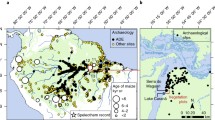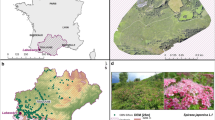Abstract
With the continuing decline in the global extent of tropical forests, agriculture-dominated landscapes now cover approximately 50 % of the tropical biome. In this context, our ability to understand and influence biodiversity and carbon sequestration in the tropics depends in large part on our understanding of actively managed landscapes. Approximately two-third of deforested lands become pasture in the Neotropics, and therefore, significant changes in their structure represent a potentially important development in terms of carbon sequestration and biodiversity, especially as ecosystem service payment schemes such as REDD+ emerge. The spontaneous emergence of silvo-pastoral landscapes, or pastures with trees, in formerly treeless pastures in the southern Ecuadorian Amazon represents just this kind of potentially significant shift in the structure of landscapes. In this paper, we try to explain this change in pastoral landscapes. Field surveys indicate variable densities of trees in pastures, with stem densities ranging from 30 to 400 per hectare. Analyses of interviews with the heads of small cattle ranching enterprises suggest that cattle ranchers pursue an intentional management strategy of allowing trees to regrow in working pastures to an extent that is ecologically significant. These findings confirm that even cattle ranches, albeit small in scale, can simultaneously produce food and provide important ecosystem services like carbon sequestration.

Similar content being viewed by others
References
Bernard HR (2006) Research methods in anthropology: qualitative and quantitative approaches, 4th edn. AltaMira Press, Maryland
Browder J, Godfrey B (1997) Rainforest cities: urbanization, development, and globalization of the Brazilian Amazon. Columbia University Press, New York
Chayanov AV, Thorner D, Kerblay B, Smith REF, and American Economic Association (1966) The theory of peasant economy. Published for the American Economic Association by R.D. Irwin, IL
Chazdon R, Harvey C, Komar O, Griffith D, Ferguson B, Martinez-Ramos M, Morales H, Nigh R, Soto-Pinto L, Van-Breugel M, Philpott S (2009) Beyond reserves: a research agenda for conserving biodiversity in human modified tropical landscapes. Biotropica 41(2):142–153. doi:10.1111/j.1744-7429.2008.00471.x
FAO (Food and Agriculture Organization of the United Nations) (2009) The state of food and agriculture: livestock in the balance. http://www.fao.org/docrep/012/i0680e/i0680e.pdf. Accessed 26 Dec 2013
Gray C (2009) Environment, land, and rural out-migration in the southern Ecuadorian Andes. World Dev 37(2):457–468. doi:10.1016/j.worlddev.2008.05.004
Ibrahim M, Villanueva C, Casasola F, Rojas J (2006) Silvopastoral systems as a tool for the improvement of productivity and restoration of the ecological integrity of cattle production landscapes. Pastos y Forrajes 29(4):383–419
Instituto Nacional de Estadísticas y Censos (INEC) (2010) Censo Nacional de Población y Vivienda. http://www.inec.gob.ec/estadisticas/. Accessed 26 Dec 2013
James P (1959) Latin America, 3rd edn. Odyssey Press, New York
Jokisch B, Pribilsky J (2002) The panic to leave: economic crisis and the “new emigration” from Ecuador. Int Migr Rev 40(4):75–101. doi:10.1111/1468-2435.00206
Lambin EF, Meyfroidt P (2010) Land use transitions: socio-ecological feedback versus socio-economic change. Land Use Policy 27:108–118. doi:10.1016/j.landusepol.2009.09.003
Larrea C (2004) Dolarización y desarollo humano en el Ecuador. Iconos 19:43–53
Mather A, Needle C (1998) The forest transition: a theoretical basis. Area 30(2):117–124. doi:10.1111/j.1475-4762.1998.tb00055.x
Murgueitio E, Calle Z, Uribe F, Calle A, Solorio B (2011) Native trees and shrubs for the productive rehabilitation of tropical cattle ranching lands. For Ecol Manag 261:1654–1663. doi:10.1016/j.foreco.2010.09.027
Netting R (1993) Smallholders, householders: farm families and the ecology of intensive, sustainable agriculture. Stanford University Press, California
Pan Y, Birdsey RA, Fang J, Houghton R, Kauppi PE, Kurz WA, Phillips OL, Shvidenko A, Lewis SL, Canadell JG (2011) A large and persistent carbon sink in the world’s forests. Science 333:988–993. doi:10.1126/science.1201609
Perfecto I, Vandermeer J (2008) Biodiversity conservation in tropical agroecosystems: a new conservation paradigm. Ann NY Acad Sci 1134:173–200. doi:10.1196/annals.1439.011
Peters M, Rao I, Fisher M, Subbarao G, Martens S, Herrero M, van der Hoek R, Schultze-Kraft R, Miles J, Castro A, Graefe S, Tiemann T, Ayarza M, Hyman G (2012) Tropical forage-based systems to mitigate greenhouse gas emissions. Eco-efficiency: from vision to reality. International Center for Tropical Agriculture (CIAT), Cali, Colombia, pp 171–190
Phalan B, Onial M, Balmford A, Green RE (2011) Reconciling food production and biodiversity conservation: land sharing and land sparing compared. Science 333:1289–1291. doi:10.1126/science.1208742
Reardon T, Stamoulis K, Pingali P (2007) Rural nonfarm employment in developing countries in an era of globalization. Agric Econ 37:173–184. doi:10.1111/j.1574-0862.2007.00243.x
Rudel T (2009) How a reduced emissions agricultural policy can help make REDD+ work. In: Angelsen A et al (eds) Realizing REDD+: national policy options and strategies. Center for International Forestry Research, Bogor, Indonesia, pp 191–200
Rudel TK (2013) Defensive environmentalists and the dynamics of global reform. Cambridge University Press, Cambridge
Rudel TK, Horowitz B (1993) Tropical deforestation: small farmers and land clearing in the Ecuadorian Amazon. Columbia University Press, New York
Rudel TK, Bates D, Machinguiashi R (2002) A tropical forest transition? Out-migration, agricultural change, and reforestation in the Ecuadorian Amazon. Ann Assoc Am Geogr 92(1):87–102. doi:10.1111/1467-8306.00281
Rudel TK, Katan T, Horowitz B (2013) Amerindian livelihoods, outside interventions, and poverty traps in the Ecuadorian Amazon. Rural Sociol 78(2):167–185. doi:10.1111/ruso.12009
Sayer J, Sunderland T, Ghazoul J, Pfund J, Sheil D, Meijaard E, Venter M, Boedihihartono A, Day M, Garcia C, van Oosten C, Buck LE (2013) Ten principles for a landscape approach to reconciling agriculture, conservation, and other competing land uses. Proc Natl Acad Sci 110(21):8349–8356. doi:10.1073/pnas.1210595110
Schodt D (1997) Structural adjustment and poverty in a late reformer: Ecuador. Paper presented at the meetings of the Latin American Studies Association, Guadalajara, Mexico
Steinfeld H, Gerber P, Wassenaar T, Castel V, Rosales M, de Haan C (2006) Livestock’s long shadow: environmental issues and options. Food and Agricultural Organization of the United Nations, Rome
The Royal Society of London (2009) Reaping the benefits: science and the sustainable intensification of global agriculture. http://royalsociety.org/uploadedFiles/Royal_Society_Content/policy/publications/2009/4294967719.pdf. Accessed 26 Dec 2013
Tscharntke T, Clough Y, Wanger TC, Jackson L, Motzke I, Perfecto I, Vandermeer J, Whitbread A (2012) Global food security, biodiversity conservation and the future of agricultural intensification. Biol Conserv 151:53–59. doi:10.1016/j.biocon.2012.01.068
Walker R, Browder J, Arima E, Simmons C, Peereira R, Caldas M, Shirota R, deZen S (2009) Ranching and the new global range: Amazonia in the 21st century. Geoforum 40(5):732–745. doi:10.1016/j.geoforum.2008.10.009
Acknowledgments
The authors would like to thank the anonymous reviewers for their comments. This material is based upon work supported by the National Science Foundation under a Dynamics of Coupled Natural and Human Systems Grant No. 10009499. The fieldwork in Ecuador would not have been possible without the knowledge and support of Dolores Quezada and Gerardo Caivinagua, and the governments and residents of Sinai, Proaño, Huamboya, and Santa Isabel.
Author information
Authors and Affiliations
Corresponding author
Additional information
Editor: Wolfgang Cramer.
Rights and permissions
About this article
Cite this article
Lerner, A.M., Rudel, T.K., Schneider, L.C. et al. The spontaneous emergence of silvo-pastoral landscapes in the Ecuadorian Amazon: patterns and processes. Reg Environ Change 15, 1421–1431 (2015). https://doi.org/10.1007/s10113-014-0699-4
Received:
Accepted:
Published:
Issue Date:
DOI: https://doi.org/10.1007/s10113-014-0699-4




